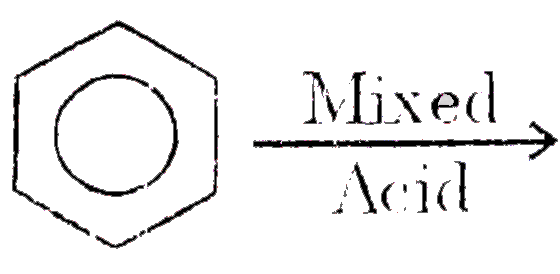XSn/HCl−−−−→NaNO2−−−−→HClZCuCN−−−→Δ(P)H3O−−→Ph−COOH correct options is/are:
X is Ph−NH2
Y is Ph−NO2
Z is Ph−NH2
P is Ph-CN
The correct Answer is:D
To solve the problem step by step, we will analyze the transformations occurring from compound X to the final product Ph-COOH.
Step 1: Identify Compound X
The first reagent is Sn/HCl, which is a reducing agent. It is used to reduce nitro groups (NO2) to amine groups (NH2). Therefore, we can conclude that:
- X = Ph-NO2 (Nitrobenzene)
Step 2: Reduction of X to Y
When X (Ph-NO2) is treated with Sn/HCl, it is reduced to an amine:
- Y = Ph-NH2 (Aniline)
Step 3: Diazotization of Y to Z
Next, Y is treated with NaNO2 in HCl. This reaction is known as diazotization, where an amine is converted to a diazonium salt:
- Z = Ph-N2^+ Cl^- (Benzene diazonium chloride)
Step 4: Reaction of Z with CuCN to form P
The diazonium salt Z is then treated with CuCN, which introduces a cyanide group (CN) to the aromatic ring:
- P = Ph-C≡N (Benzene cyanide)
Step 5: Hydrolysis of P to form the final product
The final step involves the hydrolysis of P (Ph-C≡N) using H3O^+. This reaction converts the nitrile group (C≡N) into a carboxylic acid (COOH):
- Final Product = Ph-COOH (Benzoic acid)
Summary of the transformations:
- X = Ph-NO2
- Y = Ph-NH2
- Z = Ph-N2^+ Cl^-
- P = Ph-C≡N
- Final Product = Ph-COOH
Correct Option
From the analysis, we can conclude that the only correct statement is:
- P is Ph-C≡N, which is correct.
The first reagent is Sn/HCl, which is a reducing agent. It is used to reduce nitro groups (NO2) to amine groups (NH2). Therefore, we can conclude that:
- X = Ph-NO2 (Nitrobenzene)
When X (Ph-NO2) is treated with Sn/HCl, it is reduced to an amine:
- Y = Ph-NH2 (Aniline)
Next, Y is treated with NaNO2 in HCl. This reaction is known as diazotization, where an amine is converted to a diazonium salt:
- Z = Ph-N2^+ Cl^- (Benzene diazonium chloride)
The diazonium salt Z is then treated with CuCN, which introduces a cyanide group (CN) to the aromatic ring:
- P = Ph-C≡N (Benzene cyanide)
The final step involves the hydrolysis of P (Ph-C≡N) using H3O^+. This reaction converts the nitrile group (C≡N) into a carboxylic acid (COOH):
- Final Product = Ph-COOH (Benzoic acid)
- X = Ph-NO2
- Y = Ph-NH2
- Z = Ph-N2^+ Cl^-
- P = Ph-C≡N
- Final Product = Ph-COOH
From the analysis, we can conclude that the only correct statement is:
- P is Ph-C≡N, which is correct.
Topper's Solved these Questions
- BOOK - RESONANCE ENGLISHCHAPTER - AROMATIC COMPOUNDS EXERCISE - Section -2 (one or more than one options correct type)7videos
AROMATIC COMPOUNDS
- BOOK - RESONANCE ENGLISHCHAPTER - AROMATIC COMPOUNDS EXERCISE - Section-4: Comprehension type(Only one options correct)1videos
AROMATIC COMPOUNDS
- BOOK - RESONANCE ENGLISHCHAPTER - AROMATIC COMPOUNDS EXERCISE - PART-II: NATIONAL STANDARD EXAMINATION IN CHEMISTRY (NSEC) STAGE-I31videos
AROMATIC COMPOUNDS
- BOOK - RESONANCE ENGLISHCHAPTER - ATOMIC STRUCTUREEXERCISE - ORGANIC CHEMISTRY(Fundamental Concept )16videos
ATOMIC STRUCTURE
Similar Questions
Knowledge Check
- Question 1 - Select One
In the given reaction sequence
C6H5NO2Sn/HCl−−−−→ANaNO2+HCl−−−−−−−−→BCuCN/HCN−−−−−−−−→CH2∅H⊕−−−−→ΔD
Which one is not correct ?AA is C6H5NH2BB is C6H5−⊕N≡N−ClCC is C6H5CH2CNDD is C6H5COOH - Question 2 - Select One
Ph−O∣∣C−CH3NaNO2−−−−→HCl(A)AC2O−−→heat(B)H3O+−−−→(C)
Product ( C) of the above reaction is :APh−CO2HBPh−O∣∣C−CO2HCPh−O∣∣C−O∣∣C−HDPh−O∣∣C−CH2OH
Aniline in a set of reactions yielded a product D
 NaNO2−−−−−−→HClACuCN−−−→BH2−−−−−→NiCHNO2−−−→D
NaNO2−−−−−−→HClACuCN−−−→BH2−−−−−→NiCHNO2−−−→D
The structure of produce D would beView SolutionIn the reaction sequence
CH3−O∣∣C−H−HCN−−−→.ΘOH(A)H2O/⊕H−−−−→Δ Product is/are :View Solution NaNO2−−−−−−→HClACuCN−−−→BH3O+−−−→C.C is identified asView Solution
NaNO2−−−−−−→HClACuCN−−−→BH3O+−−−→C.C is identified asView Solution
P(Monosubsitituted benzene)Na(Hg)−−−−−−−−→+conc.H2SO4QNaNO2−−−−−−−−→+HCl.0∘.5∘CRKCN−−−→CuCNSSnCl2−−−→HClT
Correct statement are :View SolutionPh−OH∣C∣Me−Me∣C∣I−PhAgNO3−−−→Δ? Major product is
View SolutionIn which of the following reactions benzaldehyde is the final major products
(i)Ph−CH3+CrO3+(CH3CO)2O273−283K−−−−−−→H3O+−−−→Δ
(ii) Ph−CH3−Cl2−−→hvPh−CHCl2H2O−−−→100∘C
(iii)C6H6CO+HCl−−−−−→AlCl3
(iv)Ph−COCl+(CH3)2Cd→View Solution


